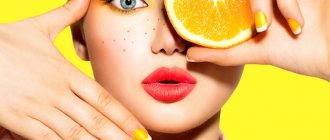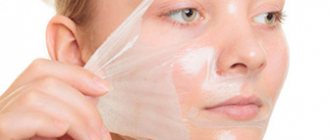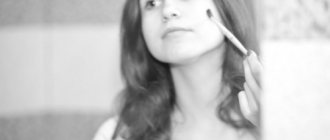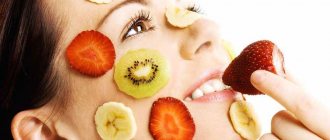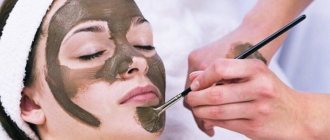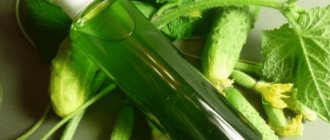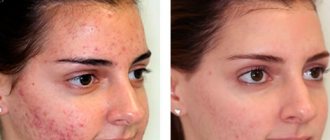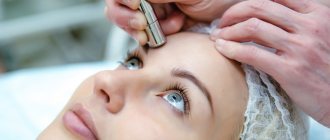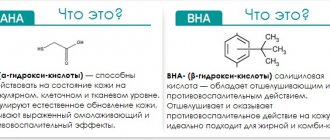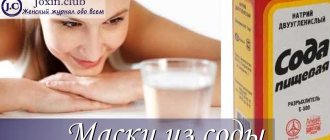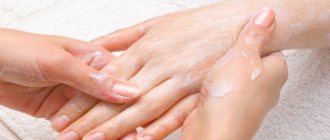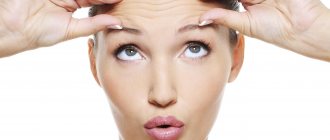Salons often recommend yellow peeling (or retinoic peeling). The method has established itself as a “weekend measure” with good results in a short time.
To find out everything about yellow peeling, it is not enough to understand what effect it has: you need to familiarize yourself with the contraindications and possible consequences, because your usual way of life depends on them. Let's try to figure it out.
Retinoic facial peeling: what is it?
Retinoic peeling is based on the use of retinoic acid, and its main effect is exfoliation of the top layer of skin. Because of its color, retinoic peels are also called yellow peels.
The yellow color of the cosmetic composition is provided by retinoic acid, which is based on beta-carotene - a plant pigment, a derivative of vitamin A (or retinol).
Retinol (vitamin A) is a fat-soluble vitamin that enters the body with food and accumulates in the liver. It is found in large quantities in plants: yellow and green vegetables (peppers, carrots, pumpkin, spinach and others), parsley, mint, rose hips, etc. Animal foods also contain vitamin A: fish oil, butter, milk, egg yolk and cod liver are rich in it.
Advantages and disadvantages
Retinoic
Advantages of this procedure:
- renewal of skin structure;
- slowing down pigmentation;
- lightening skin tone;
- smoothes the surface of the face;
- fine facial wrinkles go away;
- increases collagen in the skin;
- perfectly moisturizes;
- helps to independently produce your own hyaluronic acid;
- improves blood flow in capillaries;
- improves skin condition after acne;
- helps to better produce nutrients;
- the skin on the face becomes radiant and healthy in appearance;
- the procedure takes place without pain and discomfort;
- the result will be visible after the first use;
- Suitable for all skin types;
- skin restoration occurs in just a week;
- the skin becomes protected from harmful bacteria;
- a healthy glow appears;
- After a full course, the effect can last up to six months.
Flaws:
- The procedure takes a lot of time as it is done in two stages. Therefore, before going to the salon, cancel all your activities for the next few hours.
- After the session, the skin will have a yellow tint, so many people try to stay at home for a week after the procedure.
- Unpleasant itching will be your companion for a week.
- The procedure itself takes about half an hour, but the mask that is applied to the skin cannot be washed off for several hours. Therefore, you need to either go home straight away or wait in the salon.
- Under no circumstances should the skin be exposed to sunlight, otherwise it will become completely covered with pigment spots. To prevent this from happening, it is necessary to use protective creams with a high UV index.
- Peeling should not be done in the summer, or before going on vacation to hot countries.
- High price of the procedure.
- Wrinkles do not disappear, but return after a while.
- Skin turgor decreases, so the procedure must be done repeatedly.
Retinol
Basically, the benefits of retinol peeling coincide with those described above. But unlike it, retinol peeling does not give the skin a yellow tint. This procedure can be used by people with wide pores, fair skin and age spots. This peel does not penetrate as deeply as a retinoic peel, so the skin will not peel off. But the effect of skin renewal will be weaker, so you can do a session of this procedure at any convenient time.
- Retinoic peeling should be used to renew facial skin, eliminate any defects and achieve a more fresh look. This procedure is not harmful if it is carried out correctly, but side effects, as a rule, cannot be avoided, so for the sake of an excellent result you will have to put up with them for a while.
- Retinol peeling is suitable for all skin types and does not cause severe side effects. But the effect will be weaker and only once.
Composition of retinoic peeling
Peeling is a cosmetic product consisting of several ingredients. The composition of retinoic peeling includes, respectively, retinol (or retinoic acid) and some excipients.
Chemical retinol peeling is used in cosmetology to rejuvenate and eliminate age-related skin imperfections. It is used on different areas of the body: face, neck and décolleté. However, you should protect your eyes from getting chemicals in them.
Yellow peeling is suitable for both superficial and medium peeling, but the latter is performed only by a cosmetologist!
Contraindications
In what cases can retinoic peeling be contraindicated for a patient? As a rule, exposure is not recommended for:
- allergies or individual intolerance to the components of the drug;
- the presence of viral infections aggravated by the procedure;
- the presence of warts on a problem area of the body or face;
- skin hypersensitivity to sunlight;
- taking medications that are incompatible with the drugs used for peeling;
- pregnancy and breastfeeding;
- presence of subcutaneous mites;
- liver diseases.
Retinol peeling is also contraindicated during pregnancy planning.
Three “don’ts” in skin care after retinol peeling
- Do not use aggressive cosmetics that contain alcohol and other active substances.
- You can't scrub your skin.
- You cannot remove flaky skin on your own.
The rehabilitation period ranges from 48 hours to a week - everything is individual. On the first day, there may be slight swelling and a rise in temperature - this is a reaction to a chemical burn. Facial care in this case consists of applying Panthenol to the skin.
If severe peeling occurs, a feeling of tightness of the skin occurs - sprinkling with thermal water will help to cope with this.
Important! Recommendations for skin care are given by a cosmetologist. Be sure to follow them!
HOW THE SESSION WORKS
Preparing for the yellow mask
Depending on the type and condition of the tissue, pre-peeling preparation may take several days or extend over weeks. Each case is considered individually.
It is worth finding out in advance whether there are any contraindications to the procedure: for example, checking the level of vitamin A, otherwise retinoic peeling may result in unpleasant consequences.
At the preparatory stage, it is recommended to carry out several sessions of gentle cleansing with fruit exfoliants in order to remove the top layer of cells and enhance the effect of retinoic acid.
We recommend: GAS-LIQUID PEELING OF THE SCALP: a therapeutic “shower” of the 21st century
Protocol
- At the first stage, a product based on salicylic or glycolic acid is applied to the face; the goal is to activate the production of collagen and elastin, thereby enhancing the effect of the main drug.
- Then , without washing off the previous product, a preparation based on retinoic acid is applied to the skin. The effectiveness of the product depends on its concentration, as well as the duration of the procedure: the higher the concentration, the longer it is necessary to keep the mask on the face.
- If the purpose of the procedure is superficial cleaning, you can wash off the mask after half an hour. For deeper rejuvenation, the product should remain longer: up to 6-12 hours.
- Wash off the mask with neutral soap , then apply Panthenol-based ointment (it will speed up the healing process).
During the procedure, you may experience a slight burning sensation: this is completely normal. After removing the mask, a feeling of skin tightness, slight itching and tingling, and swelling appears, which also should not cause serious concern.
Peeling with retinoic ointment at home
Retinoic ointment is a drug for the treatment of acne.
Acne (or acne) is an inflammation of the sebaceous glands of the hair follicle. The ointment includes 1 mg isotretinoin. The action of the drug is aimed at reducing sebum production, reducing inflammation and excessive formation of epithelium. You can treat yourself with this ointment at home, but it is not suitable for peeling.
How to make retinol peeling at home, and can you prepare the composition yourself?
The Internet is full of information that you can do retinol peeling yourself, and the procedure done at home is no different from salon peeling (but costs an order of magnitude cheaper) - but this is not so!
Doing retinoic peeling at home is strictly prohibited! This is a medical procedure, it is simply dangerous to carry out it yourself - you can cause considerable harm to your skin. Peeling contains acids that cause chemical burns, and if peeling is performed incorrectly and ineptly, the consequences can be simply sad.
You can also find a recipe online for preparing yellow peeling with retinoic acid - you should not skimp on your own health and test this composition on yourself. It is impossible to prepare the peeling yourself. Retinoic acid is an aggressive substance that penetrates deeply into the skin. If the procedure is described and used unprofessionally, medium peeling is dangerous.
Procedure protocol
When preparations for facial peeling have been completed, you can begin cleansing. Yellow peeling is done in a beauty salon and at home. If you are confident in your own abilities and skills, you can safely carry out the cleaning yourself. To be sure that your actions are correct, first visit a cosmetologist, clarify the details of exfoliation and listen to the specialist’s recommendations for further care.
The retinoic peeling protocol involves the following procedure:
- Remnants of makeup, dust, particles of dirt and grease are removed from the surface.
- Next, a peeling agent is applied to the cleaned area. Outwardly, it looks like a yellow mask.
- Further actions depend on the selected peeling agent, as well as the manufacturer’s instructions. If peeling is intended for one day, then the patient goes home, and after the time specified in the instructions for the product, washes off the peeling mask from the face. If you chose the two-day option, then after a short period of time the cosmetologist washes off the mask and applies the peeling again. The client also goes home, where he washes off the remaining product. The next day the procedures are repeated.
How long to keep the composition on the face and how many times to repeat applications is specified by the manufacturer in the instructions for use. Therefore, carefully study the instructions included with the drug so as not to provoke unpleasant consequences and not to harm yourself!
Who needs yellow peeling: indications for use
- Cases of manifestation of the first age-related changes in the skin: wrinkles, peeling and a feeling of dryness.
- Pigmentation disorders, the appearance of obvious pigment spots on the face.
- Acne and acne, remaining scars. The procedure helps smooth out scars and make them less noticeable.
- Reduced skin turgor and elasticity. After peeling, the skin becomes more youthful and “alive”.
- Photoaging. The sun triggers the process of skin dehydration, pigment formation and early skin aging.
Preparation
The described procedure is carried out on the face, décolleté, back and arms. Before you start applying the mask to your skin, you must first prepare it in a special way. This takes varying amounts of time (it can take 4 days or a month).
Main stages of preparation:
- Examination by specialists and passing tests that would reveal possible negative reactions to the composition of the mask;
- If herpes often appears on the face, you need to take special medications that will help cure this disease;
- Regular application of cosmetics to the skin, which contain a predominant high concentration of fruit acids;
- Preliminary carrying out other peelings with fruit acids;
- Using nourishing creams that would soften the skin well.
IMPORTANT! If you do not follow the cosmetologist’s recommendations regarding the preparatory stages, then in the end you will not be able to achieve the maximum result from the procedure. You can only avoid them if you have very thin or sensitive skin.
All preliminary procedures are aimed at removing dead skin cells and softening it as best as possible. This is necessary in order to help retinoic and other acids better perform their basic functions in the future.
A tan that appears on the skin in less than a week can worsen the procedure. In addition, before peeling you do not need to undergo laser procedures and stay in the sun for a long time.
Poll: Have you had this procedure done?
Total votes: 28. Total participants: 28.
Retinoic or TCA peeling: which is better?
Both procedures have proven to be an effective way to combat age-related changes and skin imperfections. They are equally used for superficial and medium peeling. But they are different in chemical composition and mechanism of action.
Each procedure has its own indications and contraindications. Serious complications are also possible.
What to choose? The decision is made by the doctor based on the characteristics of the patient’s skin, the problem being solved and the body’s individual tolerance. After all, a professional approach is important in solving any cosmetic problem.
Retinol facial peeling: real reviews
In the fall, I took a peeling course of 4 procedures from a cosmetologist, using products from the Israeli company Holy Land (Alpha-beta & Retinol).
I will attach my photos before and after the procedure:
A little about my skin - combination, prone to closed comedones and especially oily in the T-zone. On the third day after the first procedure, the skin under the nose began to peel off in small flakes. The feeling of tightness and dryness did not leave for another 10 days, despite the fact that I toned the skin and moisturized once an hour. After 2 weeks, the discomfort left me, and we repeated the procedure. The second time, the skin peeled off all over my face in large pieces, but I began to notice the first results. Subsequent procedures were no longer so traumatic, but the feeling of tightness was present throughout the entire course. After that, I switched to home care and I can assure you that I have not found a better product for my skin than peeling. I gave up scrubbing my face and got rid of many long-standing problems.
Preparatory stage
You should begin preparing for the procedure with a consultation with a cosmetologist. The doctor will examine the skin, talk, and prescribe the necessary tests. If the decision is positive about the possibility of performing Cimel retinoic peeling, the cosmetologist will discuss the rules for preparing for the intervention.
An important point will be the mandatory refusal to tan. Avoid exposure to the sun, visiting a solarium, and use sunscreen when going outside. The duration of the insolation restriction depends on the condition of the skin: for weakly pigmented tissues, 2 weeks of preparation is enough, for those with a dark tone - at least a month.
2-4 weeks before the procedure, it is important to avoid the use of vitamin A, medications, cosmetics with a high percentage of retinol, and its derivatives. At the same time, they carefully monitor the health and condition of the integument. Various injuries and tissue microtraumas are excluded.
Important! The intervention is not carried out during the period of preparation for conception. This is important for the patient to remember. Failure to comply with this requirement can cause various problems during pregnancy.
The cosmetologist will indicate the need for additional preparation of the skin for the intervention. 2-3 weeks before the session, it is advisable to switch to the use of Martinex skincare cosmetics (products from the MedicControlPeel line). Cleanser Mousse foam is used to cleanse the skin. Prepeel Medium is used as a night cream (prepeel Light can be lighter). When going outside, it is recommended to use Mediscreen with a high protection factor.
Proper preparation will increase the effectiveness of the results. There is no need to ignore the recommendations of a cosmetologist. If the quality of the tissue is insufficient, the doctor may refuse to perform the procedure. Intervention is possible both in winter and summer, but during periods of increased solar activity it is more difficult for the patient to fulfill important requirements, the violation of which can lead to complications.
